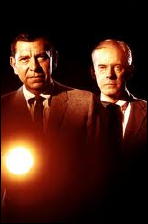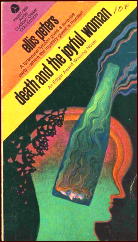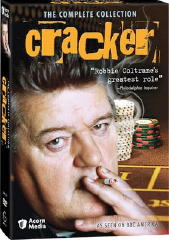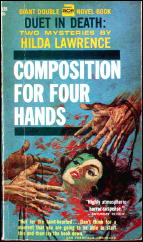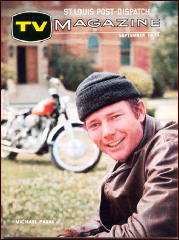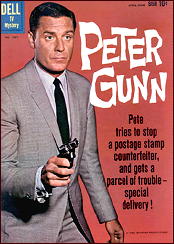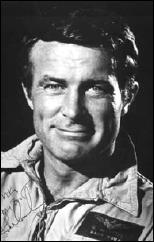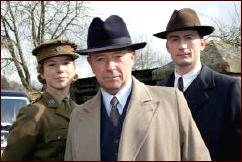● LOIS & CLARK: THE NEW ADVENTURES OF SUPERMAN. Feature-length premiere of the TV series. ABC-TV, 12 September 1993. Dean Cain (Clark), Teri Hatcher (Lois), with Michael Landes (Jimmy), Lane Smith (Perry White), John Shea (Lex Luthor), & Tracy Scroggins (“Cat” Grant). Based on the DC Comics superhero characters. Director: Robert Butler.

“Look, up in the sky! It’s a bird! It’s a plane! It’s a guy up there in a costume, with a cape!”
Or words to that effect.
A retelling of Clark Kent’s first days at the Daily Planet, how he meets Lois Lane, star reporter, how he foils Lex Luthor’s attempt to sabotage a new space station, and why on Earth he needs a secret identity and a costume anyway.
More entertaining than any of the big-budget movies, this much more reasonable facsimile of the long-running comic book is flawed by a certain lack of subtlety, but I still found it a lot of fun. (And it goes almost without saying that I would have preferred Margot Kidder, who must not have been available, there’s no kidding about that.)
COMMENT: Why is it that whenever I watch network television any more, no matter what I watch, that everybody on every show always seems younger than I am?
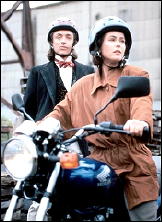
● 1994 BAKER STREET: SHERLOCK HOLMES RETURNS Made for TV, 1993 CBS, 12 September 1993. Anthony Higgins, Debrah Farentino, with Ken Pogue as James Moriarty Booth. Based on the characters created by Arthur Conan Doyle. Director & screenwriter: Kenneth Johnson.
Not to be confused with The Return of Sherlock Holmes, a 1987 TV-movie with almost the same opening plot lines, except that (as I recall) the city then was Boston, and this time it’s San Francisco.
When Holmes is popped out of the deep-freeze machine he’s been in for nearly 100 years, he suddenly has to confront all the changes that have taken place in the world, and when he tries to dazzle it with his amazing deductive abilities, the results are, sorry to say, not always on the mark.
Lots of opportunity for little bits of comedy, in other words, as well as a hint of romance. Not as bad as perhaps I’m making it sound, but still not very good.
COMMENT: Personally, I think that every piece of fiction that has been written about Sherlock Holmes since Conan Doyle died has been fundamentally a bad idea, and they’ve all had to start building from there. With the probable exceptions of Anthony Boucher and John Dickson Carr, everybody else should have forgotten the idea.
— Reprinted from Mystery*File #35, November 1993,
slightly revised.
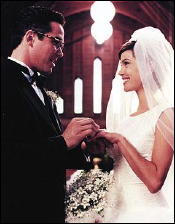
[UPDATE] 06-10-10. First of all, let me point out, in case you hadn’t noticed, that these two network movies were shown on the same evening, which I’m sure was a Sunday. Luckily we’d had our VCR for some time by then. What did people do without them? The good old days were often not so good.
Secondly, note my stated preference for Margot Kidder as Lois Lane, rather than Teri Hatcher, but as the series went on, I believe the latter’s charms began to sway my preferences a tad.
Both she and Dean Cain were complete unknowns when the series began, and it stayed on the air for four years. I think it lost a lost of momentum when Lois and Clark got married (long before they did in the comic book), but at the time, the ratings went sky-high.
And by the way, those of you who have met me in person. Doesn’t Dean Cain look a lot like me? If I were as good-looking as Dean Cain?
Although I should still have them on videocassette, I recently purchased the first season’s shows on DVD. I’ve not watched them yet, and perhaps I won’t for a while, for fear of being disappointed. I enjoyed the series then; maybe I won’t so much now. (Yes, I know. The boxed set shown is that of the second season.)
As for the Sherlock Holmes movie, I don’t know why I was so hard on all of the books and movies based on Doyle’s characters, and believe it or not, I softened my phrasing in that comment above from the way I said it in 1993. They are what they are, some are better than others, and they’re all fun.
The Return of Sherlock Holmes, which I mentioned being the same story as Sherlock Homes Returns, only earlier, was previously mentioned on this blog back here. It’s in Comment #2 following a review of The Missing Person, another movie with Margaret Colin in it.
